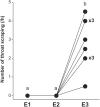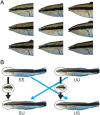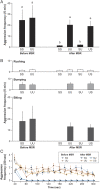Cleaner fish recognize self in a mirror via self-face recognition like humans
- PMID: 36745814
- PMCID: PMC9963968
- DOI: 10.1073/pnas.2208420120
Cleaner fish recognize self in a mirror via self-face recognition like humans
Abstract
Some animals have the remarkable capacity for mirror self-recognition (MSR), yet any implications for self-awareness remain uncertain and controversial. This is largely because explicit tests of the two potential mechanisms underlying MSR are still lacking: mental image of the self and kinesthetic visual matching. Here, we test the hypothesis that MSR ability in cleaner fish, Labroides dimidiatus, is associated with a mental image of the self, in particular the self-face, like in humans. Mirror-naive fish initially attacked photograph models of both themselves and unfamiliar strangers. In contrast, after all fish had passed the mirror mark test, fish did not attack their own (motionless) images, but still frequently attacked those of unfamiliar individuals. When fish were exposed to composite photographs, the self-face/unfamiliar body were not attacked, but photographs of unfamiliar face/self-body were attacked, demonstrating that cleaner fish with MSR capacity recognize their own facial characteristics in photographs. Additionally, when presented with self-photographs with a mark placed on the throat, unmarked mirror-experienced cleaner fish demonstrated throat-scraping behaviors. When combined, our results provide clear evidence that cleaner fish recognize themselves in photographs and that the likely mechanism for MSR is associated with a mental image of the self-face, not a kinesthetic visual-matching model. Humans are also capable of having a mental image of the self-face, which is considered an example of private self-awareness. We demonstrate that combining mirror test experiments with photographs has enormous potential to further our understanding of the evolution of cognitive processes and private self-awareness across nonhuman animals.
Keywords: mental image; mirror self-recognition; photograph mark-test; self-awareness; self-face recognition.
Conflict of interest statement
The authors declare no competing interest.
Figures




Comment in
-
This fish knows its own face in a mirror.Nature. 2023 Feb;614(7948):393. doi: 10.1038/d41586-023-00352-2. Nature. 2023. PMID: 36750701 No abstract available.
-
Reply to Morin: Cleaner fish have a concept of the self.Proc Natl Acad Sci U S A. 2023 May 9;120(19):e2303923120. doi: 10.1073/pnas.2303923120. Epub 2023 May 1. Proc Natl Acad Sci U S A. 2023. PMID: 37126680 Free PMC article. No abstract available.
-
Self-awareness in fish?Proc Natl Acad Sci U S A. 2023 May 9;120(19):e2303377120. doi: 10.1073/pnas.2303377120. Epub 2023 May 1. Proc Natl Acad Sci U S A. 2023. PMID: 37126709 Free PMC article. No abstract available.
-
Beyond the mark: Signatures of self-recognition in fish.Learn Behav. 2024 Mar;52(1):5-6. doi: 10.3758/s13420-023-00586-0. Epub 2023 May 25. Learn Behav. 2024. PMID: 37231105
References
-
- Keenan J. P., Gallup G. G., Falk D., The Face in the Mirror: The Search for the Origins of Consciousness (Ecco, New York, 2003).
-
- Parker S. T., Mitchell R. W., Boccia M. L., Self-Awareness in Animals and Humans, Developmental Perspectives (Cambridge University Press, 2006).
-
- Morin A., Levels of consciousness and self-awareness: A comparison and integration of various neurocognitive views. Conscious. Cogn. 15, 358–371 (2006). - PubMed
-
- Morin A., Self-reported inner speech illuminates the frequency and content of self-as-subject and self-as-object experiences. Psychol. of Conscious. 9, 93–100 (2022).
-
- Gallup G. G., Chimpanzees: Self-recognition. Science 167, 86–87 (1970). - PubMed
Publication types
MeSH terms
LinkOut - more resources
Full Text Sources

